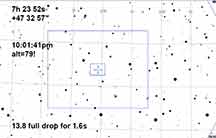


This event is tougher; only W=13.8 magnitude so will take some integration. But nominally the path is high rank, lasts 1.6s which should permit a well-determined positive. Skies are partly cloudy but mostly clear, is the prediction. The path is over the SC Mtns, and the southern limit hits Kirk at home, but Karl is inside the southern limit, and I plan to try this from the Bike Crossing at the Upper Meadow of UCSC, if weather is good. I'll also be up there for the other occultation by Klumpkea an hour before that. Between events, probably some testing and some photography.
The target is 76 degrees up 1/2 hr before the event, rising higher and maxing at 79 degrees altitude during the event. Will require tilting the tripod properly. The target will be on the north side of the zenith, so tilt your tripod so that the base is tilting TOWARDS the north star more. 79 deg, in my experience may just barely be do-able but only with that tilt. Else, use the 0.5x reducer. But because the target is so faint, good optics will be important and the 0.5x reducer isn't ideal. Myself; I will plan to tilt the tripod.
If you're going to let the tripod track all during the hour between event, be sure you battery is fully charged beforehand, and to do the tripod tilting before you set up for Klumpkea.
 |
 |
 |
Kirk and I tried this one; Karl did not; too faint.
I drove up to the upper meadow at UCSC and got set up efficiently. However, by the time I had dome a two-star alignment (Polaris and Sirius) and then did a GoTo the target, I had only a few minutes left. This occultation was less than an hour after the Klumpkea event at the entrance to Natural Bridges. I was not able to ID the star field. I had to tip the tripod to make sure this 79 degree altitude event was not going to bang the Watec against the base. I'm wondering now whether the tipped tripod is not well compensated for by the mount. I'm wondering if good GoTo requires a fairly level tripod. I still did a recording on the star field coordinates, but I could not ID those stars, neither before nor after the event. The telescope can only tolerate a small degree of non-level before failing on GoTo to high altitude targets. Higher than 76 degrees altitude will require the 2" diagonal / 1.25" adapter, and 0.5x nosepiece reducer.
Kirk observed from home. Got a ~1.5s positive on Klumpkea and not sure of his results on 1996ER1. Trouble due due on corrector plate, but did ID star field, after flattening the tripod and re-aligning. I will post his light curves soon.
 |
 |